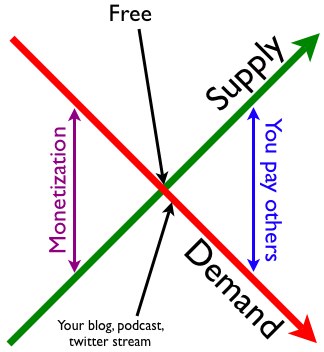Monetization and social media
Get rich quick! Quit your day job! Money while you sleep! All claims made of social media and virtually every other new technology, idea, or movement since mankind first created money itself. Can you make money in social media? Should you make it an aim?
To answer this question, we have to dig into the history and concept of money itself.
What is money?
Ask any child and most adults, and no one will have a coherent answer to this question. People know money by what it can do, but not what it is. The classical definition of money is a medium of exchange, a measure of account, and store of value. For the purposes of this discussion, we’re going to focus on a medium of exchange and a store of value.
A Medium of Exchange
Before money, we had barter. Let’s say I raised chickens and you raised cows. If I wanted some beef and you wanted some chicken, we’d get together and trade. We’d negotiate how many chickens equaled a cow, and vice versa. If all went well, I went home with some beef for my family and you went home with some chicken.
But… what if you didn’t want chicken? You had beef, and I wanted beef, but you didn’t want chicken? Suddenly, I have a problem. We couldn’t trade. No amount of chicken I had would be helpful to me if you didn’t want chicken. I’d have to find someone who wanted chicken and see what they had to trade. Maybe they had seashells, and you wanted seashells, so I’d have to trade chicken for seashells first, then find you and trade seashells for beef.
 This got really inefficient around Greek and Roman times, which is when currency got invented. Suddenly, we have a neutral intermediary. I think chicken is worth 5 copper coins, and you think cow is worth 250 copper coins. Now, if I have chicken and you have beef, but you still don’t want chicken, that’s fine. I’ll find someone who wants chicken and trade with them for copper coins. Then I’ll come back to you and buy as much cow as I can with the same copper coins.
This got really inefficient around Greek and Roman times, which is when currency got invented. Suddenly, we have a neutral intermediary. I think chicken is worth 5 copper coins, and you think cow is worth 250 copper coins. Now, if I have chicken and you have beef, but you still don’t want chicken, that’s fine. I’ll find someone who wants chicken and trade with them for copper coins. Then I’ll come back to you and buy as much cow as I can with the same copper coins.
This is one of the core roles of money – instead of having to barter everything, you can trade in a generally accepted medium of exchange.
A Store of Value
Here’s another problem with barter. Let’s say instead of chicken, I have wheat. You have cows. During harvest season, we can trade. I’ll trade you a few bales of wheat in exchange for a cow. Everyone’s happy.
What about in the winter, though? I have no wheat. All my wheat either got milled into flour, sold, consumed, or… spoiled. Wheat is transitory. Wheat spoils, rots, molds, etc. if you don’t use it within a certain period of time. In fact, most consumables eventually spoil.
Here’s where money comes in again. I go to the market and trade my wheat to someone who wants it. I get copper coins. Unlike wheat, these don’t spoil, decay, or rot. (yes, they do oxidize, but that’s a different conversation) If I sell enough wheat, I amass a large pile of coins and throughout the non-harvest season, I have copper coins to buy things with.
This is money’s role as a store of value. It takes the fruits of my labors – wheat – and stores it in a form that’s less subject to spoilage. Also, it’s a lot easier to carry around a pile of coins than a bale of wheat.
What does any of this have to do with new media and social media?
If you are a social media practitioner interested in earning money for your skills, you have to deeply understand money first.
First, money is a medium of exchange for other goods and services. Money doesn’t solve the value equation – that is, what you do must have value to someone. Money only makes trading value easier. If what you do is of no value to anyone, then like the farmer facing no demand for chicken, no matter how skilled you are, no one will trade with you. As a social media practitioner, your work has to have value.
The most successful social media practitioners recognize that social media in and of itself is of relatively little value. It’s a communications channel. What is of value is what you deliver to your audience. I deliver, for example, financial aid information on my Financial Aid Podcast. The fact that it’s a podcast has no inherent value; what has value is the quality of the information.
If you’re considering offering up your services to someone else as a social media practitioner, make sure that they have something of value to offer their customers, or both you and your client will fail to generate any business. Your own track record must demonstrate that you understand underlying value and how to present it in a social media context.
If you’re considering engaging the services of a social media practitioner inside your company, look to see how adept they are at understanding value. Forget how many friends they have or how often they blog – look to see if they can communicate their own value and the value of their clients’ goods and services to others. Examine their other work and see if it conveys well the value of the client’s goods and services. Most important, recognize that a truly skilled social media practitioner will decline to do business with you if your offering has no value.
Second, money as a store of value is vitally important to social media practitioners. Like all industries, social media, new media, online media, etc. all have trends. There’s a new shiny object every day, and that presents new opportunities for you to demonstrate your skills and earn some money in doing so. You have to not only capitalize on trends, but sock those earnings away. You have to be able to store the value of a trend so that when it cools – and it always does – you have a strong base of capital to operate with.
Equally important is your ability to recognize value and trends ahead of time so that as a platform matures – as blogging has – you’re ahead of the curve and in new spaces. This is the often referenced blue ocean strategy, where there’s virtually no competition in any vertical in a new area. Blue ocean was podcasting in 2005, blogging in 1997, Twitter in 2006, Facebook in 2004 and so forth. As a social media practitioner looking to earn a living at your craft, you need to be able to spot new blue oceans and move in long before others do, while recognizing that it will be some time before that space is highly desired by a large population.
For companies looking at social media, recognize that the store of value means you need operating capital and strong revenue streams today from your social media efforts, but you need to be investing for the future as well. Your internal financial health will dictate how you prioritize investing for the future vs. banking on what’s hot today.
Did you enjoy this blog post? If so, please subscribe right now!
Get this and other great articles from the source at www.ChristopherSPenn.com
10 most recent blog posts of mine:
Subscribe to RSS headline updates from:
Powered by FeedBurner



 Here’s what I wonder. His campaign amassed millions of emails and addresses. Just his campaign for announcing Senator Biden as his Vice President brought in millions of SMS numbers. His campaign brought out millions of supporters to canvas for him, to put him in office.
Here’s what I wonder. His campaign amassed millions of emails and addresses. Just his campaign for announcing Senator Biden as his Vice President brought in millions of SMS numbers. His campaign brought out millions of supporters to canvas for him, to put him in office.
 This creates a void and sets our society adrift. There is, however, a new source of leadership, of wisdom, of inspiration.
This creates a void and sets our society adrift. There is, however, a new source of leadership, of wisdom, of inspiration.
